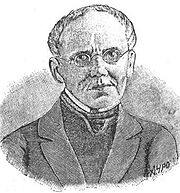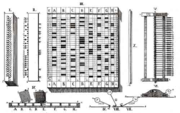
Semen Korsakov
Encyclopedia

Old Style and New Style dates
Old Style and New Style are used in English language historical studies either to indicate that the start of the Julian year has been adjusted to start on 1 January even though documents written at the time use a different start of year ; or to indicate that a date conforms to the Julian...
) was a Russia
Russia
Russia or , officially known as both Russia and the Russian Federation , is a country in northern Eurasia. It is a federal semi-presidential republic, comprising 83 federal subjects...
n government official, noted both as a homeopath and an inventor who was involved with an early version of information technology
Information technology
Information technology is the acquisition, processing, storage and dissemination of vocal, pictorial, textual and numerical information by a microelectronics-based combination of computing and telecommunications...
.
Biography
Korsakov was born in 1787 in KhersonKherson
Kherson is a city in southern Ukraine. It is the administrative center of the Kherson Oblast , and is designated as its own separate raion within the oblast. Kherson is an important port on the Black Sea and Dnieper River, and the home of a major ship-building industry...
, Ukraine
Ukraine
Ukraine is a country in Eastern Europe. It has an area of 603,628 km², making it the second largest contiguous country on the European continent, after Russia...
(then part of the Russian empire
Russian Empire
The Russian Empire was a state that existed from 1721 until the Russian Revolution of 1917. It was the successor to the Tsardom of Russia and the predecessor of the Soviet Union...
). His father was a military engineer. The family had migrated from Lithuania in the 14th century.
He was married to Sofia Mordvinova and they had four daughters and six sons, one of whom, Mikhail Semyonovich (1826–1871), became famous in his own right as governor-general of Eastern Siberia and was the namesake of the town of Korsakov
Korsakov (town)
Korsakov is a town in Sakhalin Oblast, Russia. It is the administrative center of Korsakovsky District. Population: 35,079 ; The town is located some south from Yuzhno-Sakhalinsk, at the southern end of Sakhalin Island, on the coast of the Salmon Cove in the Aniva Bay.-History:Little is known...
in Sakhalin Oblast
Sakhalin Oblast
Sakhalin Oblast is a federal subject of Russia comprising the island of Sakhalin and the Kuril Islands.The oblast has an area of 87,100 km² and a population of 546,695...
and several Russian geological features.
From 1812–1814, Semen Korsakov took part in the Napoleonic Wars
Napoleonic Wars
The Napoleonic Wars were a series of wars declared against Napoleon's French Empire by opposing coalitions that ran from 1803 to 1815. As a continuation of the wars sparked by the French Revolution of 1789, they revolutionised European armies and played out on an unprecedented scale, mainly due to...
with the Russian Army. He later was to serve as an official in the statistics
Statistics
Statistics is the study of the collection, organization, analysis, and interpretation of data. It deals with all aspects of this, including the planning of data collection in terms of the design of surveys and experiments....
department of the Russian Police Ministry in St. Petersburg. He was a recipient of the Order of St. Anna
Order of St. Anna
The Order of St. Anna ) is a Holstein and then Russian Imperial order of chivalry established by Karl Friedrich, Duke of Holstein-Gottorp on 14 February 1735, in honour of his wife Anna Petrovna, daughter of Peter the Great of Russia...
and the Order of St. Vladimir
Order of St. Vladimir
The Cross of Saint Vladimir was an Imperial Russian Order established in 1782 by Empress Catherine II in memory of the deeds of Saint Vladimir, the Grand Prince and the Baptizer of the Kievan Rus....
.
Korsakov died in 1853 in the village of Tarusovo, then part of the Moscow Province
Moscow Governorate
Moscow Governorate , or Government of Moscow, was an administrative division of the Russian Empire, which existed in 1708–1929....
.
Homeopathy
Though Korsakov was not formally trained as a doctor, he was interested in medicine, possibly because of the difficulty in getting medical care in the rural area where he lived. According to his journals he treated several thousand patients, at first using conventional medicineEvidence-based medicine
Evidence-based medicine or evidence-based practice aims to apply the best available evidence gained from the scientific method to clinical decision making. It seeks to assess the strength of evidence of the risks and benefits of treatments and diagnostic tests...
, but in 1829 switching to homeopathy
Homeopathy
Homeopathy is a form of alternative medicine in which practitioners claim to treat patients using highly diluted preparations that are believed to cause healthy people to exhibit symptoms that are similar to those exhibited by the patient...
at the urging of his relatives.
Korsakov is noted in homeopathic circles as the originator of the Korsakovian method of dilution, which differed from the Hahnemann
Samuel Hahnemann
Christian Friedrich Samuel Hahnemann was a German physician, known for creating an alternative form of medicine called homeopathy.- Early life :Christian Friedrich Samuel Hahnemann was born in Meissen, Saxony near Dresden...
ian dilutions used by (and named for) homeopathy's founder in that it used a single container for a series of dilutions rather than a new container for each. Korsakov also used dilutions higher than those previously used (30C and higher). Dilutions made using his method are commonly designated with the letter "K", e.g. 15K.
Inventions


Punch card
A punched card, punch card, IBM card, or Hollerith card is a piece of stiff paper that contains digital information represented by the presence or absence of holes in predefined positions...
had been introduced in 1805, but until that time had been used solely in the textile industry
Textile industry
The textile industry is primarily concerned with the production of yarn, and cloth and the subsequent design or manufacture of clothing and their distribution. The raw material may be natural, or synthetic using products of the chemical industry....
to control loom
Loom
A loom is a device used to weave cloth. The basic purpose of any loom is to hold the warp threads under tension to facilitate the interweaving of the weft threads...
s. Korsakov was reputedly the first to use the cards for information storage.
Korsakov presented his ideas to the Imperial Academy of Sciences in St. Petersburg, but their experts rejected his application, failing to see the potential of mechanizing searches through large stores of information. His machines were largely forgotten until after the Second World War, when a revival of historical interest resulted in the publication (in 1961) of several documents from the Academy's archives relating to Korsakov's machines and the uncovering of a book about them written by Korsakov himself.
 |  |  |

